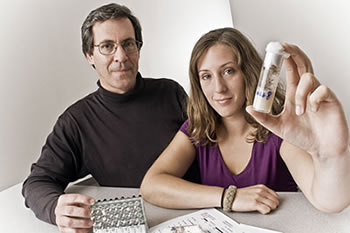
Bernard P. Possidente
Professor of Biology @ Skidmore since 1983
Address:
Department of Biology - CIS 110i
Skidmore College
Saratoga Springs, New York 12866
Telephone:
518-580-5082
Fax:
518-580-5071
E-mail: bposside@skidmore.edu
Education:
- B.A., Wesleyan University
- Ph.D., University of Iowa
- Postdoctorate, Florida State University
Courses Taught:
- Advanced Topics in Genetics (BI 352)
- Genetics (BI 245)
- Biological Clocks (BI 344)
- Genes and Generation (SSP-008 First Year Seminar)
- Human Genetics (BI 170)

of Alzheimer's Disease"
University, UK Department of Genetics,who made transgenic fly lines
with copies of mutant human genes associated with Alzheimer's.
Research Interests:
Dr. Possidente's general research area is genetic analysis of behavioral mechanisms. His research focuses on the function of biological clocks in controlling circadian (daily-endogenous) rhythms using mice and fruitflies as model systems: manipulation of rhythms in mice and fruitflies with genetic, pharmacological, and photoperiod treatments inorder to identify functional properties of circadian system components and their physiological mechanisms.
Recent Circadian Publications: (*Indicates student co-author)
- LLabre JE, Gil C*, Amatya N*, Lagalwar S, Possidente B, Vashishth D. (2022) Degradation of Bone Quality in a Transgenic Mouse Model of Alzheimer's Disease. Journal of Bone and Mineral Research.
- Nagare R., Possidente, B., Lagalwar, S. and Figueiro, M. (2020) Robust light–dark patterns and reduced amyloid load in an Alzheimer’s disease transgenic mouse model. Sci Rep10, 11436. https://www.nature.com/articles/s41598-020-68199-5.
- Kohiyama M*, Bonser D, Leung L*, Fall A*, Canada N*, Qu B, Ahmad S, Possidente B (2019) The Drosophila apterous56f mutation impairs circadian locomotor activity. Biol Rhythm Res, 46:275-285.
- Sheppard A, Hirsch HVB, Possidente B, (2015) Novel Masking Effects of Light Are Revealed in Drosophila by Skeleton Photoperiods. Biological Rhythms Research, 46 (2) 275-285.
- Chen K-F, Possidente B, Lomas DA, Crowther DC (2014) The Central Molecular Clock Is Robust in the Face of Behavioural Arrhythmia in a Fly Model of Alzheimer’s Disease. Disease Models and Mechanisms (Open Access http://dmm.biologists.org/), doi:10.1242/dmm.014134.
- Hagenauer MH, King AF, Possidente B, McGinnis MY, Lumia AR,Lee TM. (2010) Changes in Circadian Rhythms During Puberty in Rattus Norvegicus: Developmental time course and gonadal dependency. Hormones and Behavior, 60(1):46-57.
- Ruden DM, Chem L, Rasouli P, Wang L, Lu X, Garfinkel MD, Possidente D, Possidente B, Hirsch HVB, Page GP (2009) Genetical toxicogenomics in Drosophila identifies master modulatory loci that are regualted by developmental exposure to lead. NeuroToxicology, 30:898-914.
- Hirsch HVB, Possidente D, Averill S, Despain J, Buytkins J, Thomas V, Goebel P, Shipp-Hilts A, Hollocher K, Wilson D, Possidente B and D Rudin (2009) Behavioral QTL after Developmental Exposure of Drosophila melanogaster to Lead. NeuroToxicology 30:305-311.
- Possidente, B. (2007) Genetics and The Sopranos. Letters, Science 317:596.